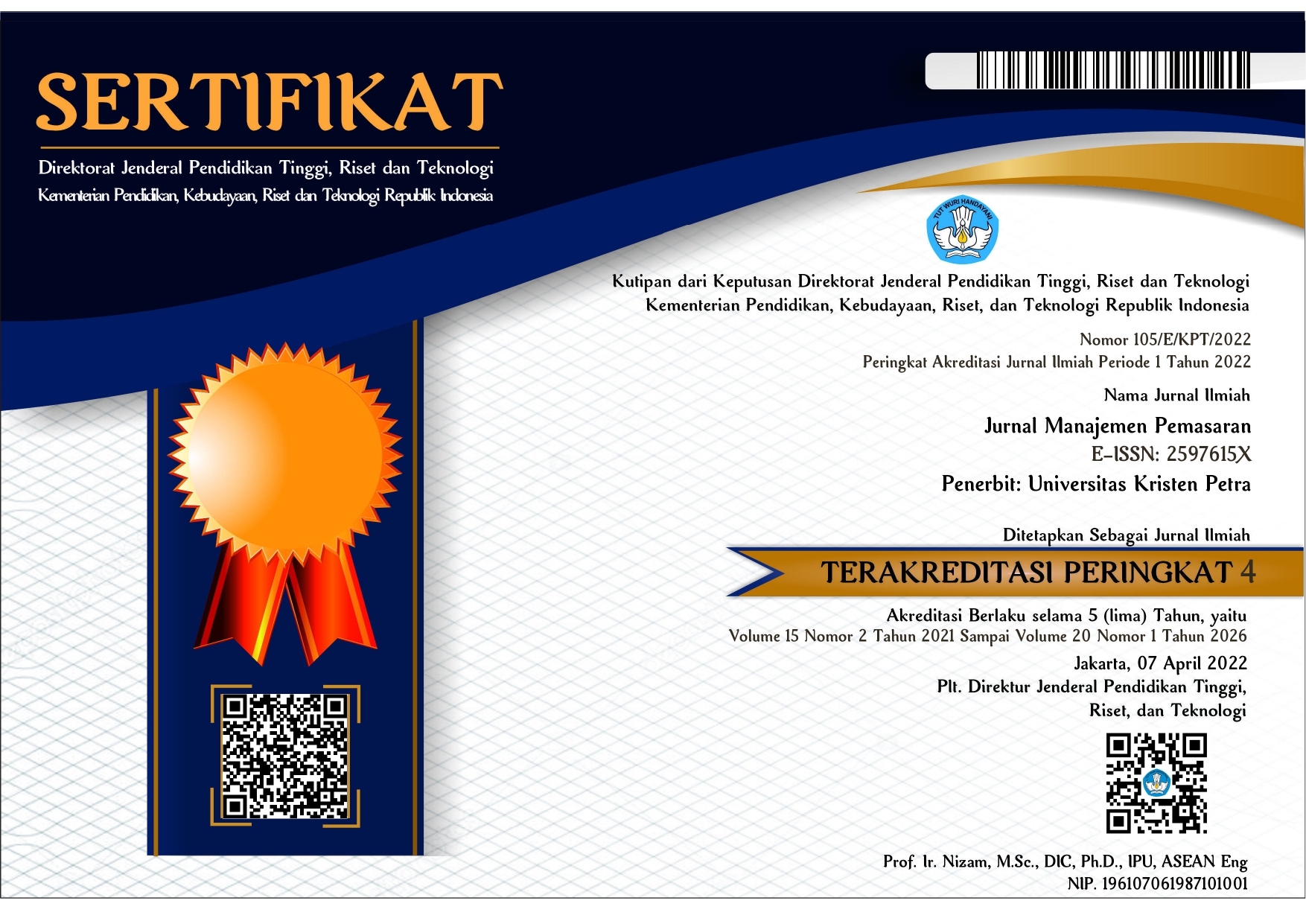PENGARUH FASHION INVOLVEMENT TERHADAP IMPULSE BUYING BEHAVIOUR MASYARAKAT SURABAYA DENGAN HEDONIC SHOPPING MOTIVATION DAN POSITIVE EMOTION SEBAGAI VARIABEL INTERVENING PADA MEREK ZARA
DOI:
https://doi.org/10.9744/pemasaran.10.1.11-19Keywords:
Fashion involvement, Hedonic shopping motivation, Positive emotions, Impulse buyingAbstract
Perkembangan bisnis ritel di Indonesia, khususnya kota Surabaya menunjukkan pertumbuhan yang signifikan. Selain itu kehidupan masyaraktnya pun juga semakin berkembang dimana semakin konsumtif dan memiliki gaya hidup serta pola belanja masyarakat (konsumen) yang senang mengikuti tren, mode, merek serta kualitas dan terkadang suasana hati juga dapat mempengaruhi seseorang dalam melakukan pembelian. Penelitian ini bertujuan untuk menganalisa pengaruh dari fashion involvement terhadap impulse buying behaviour masyarakat Surabaya dengan hedonic shopping motivation dan positive emotions sebagai variabel intervening pada merek ZARA. Penelitian ini menggunakan kuesioner yang disebar ke 100 responden yang sedang berbelanja di outlet ZARA dan menggunakan teknik analisis Data Partial Least Square (PLS). Hasil Penelitian ini menunjukkan bahwa fashion involvement berpengaruh secara positif dan signifikan terhadap impulse buying, hedonic shopping motivation berpengaruh secara positif dan signifikan terhadap impulse buying dan positive emotions berpengaruh secara positif dan signifikan terhadap impulse buying.References
Arnold, M.J., dan Reynolds, K. E. (2003). Hedonic Shopping Motivation. Journal of Retailing, 79, pp. 77–95.
Bayley, G. and Nancarrow, C. (1998). Impulse purchasing: a qualitative exploration of the phenomenon. Qualitative Market Research: An International Journal, 1(No. 2), pp. 99–114.
Cass’O, A. (2004). Fashion clothing consumption: antecedents and consequences of fashion clothing involvement. European Journal of Marketing, 38(7), pp. 869–82.
Chang, E.B., Leslie, D.,& Franchis, S. K. (2004). Gender Differences in the Dimensional Structure of Apparel Shopping Satisfaction Among Korean Consumers: The Role of Hedonic Shopping Value. Clothing and Textiles Research Journal, 22, 185.
Fairhurst, A.E., Good, L.K. & Gentry, J. W. (1989). Fashion Involvement: an instrument validation procedure. Clothing and Textiles Research Journal, 7(3), pp. 10–14.
Gultekin, B., & Ozer, L. (2012). The Influence of Hedonic Motives and Browsing on Impulse Buying. Journal of Economics and Behavioral Studies, 4(No. 3), pp. 180–189.
Hirschman, E. C., & Holbrook, M. B. (1982). Hedonic Consumption: Emerging Concepts, Method and Propositions. Journal of Marketing, 46(No. 3), pp. 92–101.
Jay, S. R. (2011). Consumers attitude and Shopping Intentions toward Pop-up Fashion Stores. Journal of Global Fashion Marketing, 139–147.
Mehrabian, A., and Russell, J. A. (1974). An Approach to Environmental Psychology. in Fisher, Feffrey D., Paul A. Bell, and Andrew Baum (1984). In Environmental Psycholog (2nd ed.). New York: Holt, Rinehart and Winston.
Park, E. J., Kim, E. Y., & Forney, J. C. (2006). A structural model of fashion-oriented impulse buying behavior. Journal of Fashion Marketing and Management, 10(4), 433–446. http://doi. org/10.1108/13612020610701965.
Rook, D.W. dan Gardner, M. P. (1993). In the mood: impulse buying’s affective antecedents. Research in Consumer Behavior, 6, pp. 1–26.
Rook, D. W. (1987). The impulse buying. Journal of Consumer Research, 9(14), pp. 189–199.
Semuel, H. (2005). Response Lingkungan Berbelanja Sebagai Stimulus Pembelian. Jurnal Manajemen Kewirausahaan, 7(2).
Seo, J., Hathcote, J.M. and Sweaney, A. L. (2001). Casualwear shopping behavior of college men in Georgia, USA. Journal of Fashion Marketing and Management, 5(No. 3), pp. 208–22.
Stern, H. (1962). The significance of impulse buying today. Journal of Marketing, 26(4), pp. 59–62.
Watson, D. and Tellegen, A. (1985). Toward a consensus structure of mood. Psychological Bulletin, 98(No. 2), pp. 219– 35.
Weinberg, P., & Gottwald, W. (1982). Impulsive consumer buying as a result of emotions. Journal of Business Research, 10(1), 43–57. Retrieved from http://dx.doi.org/10.1016/0148-2963(82) 90016-9.
















